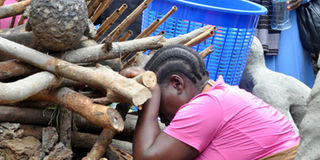Why Kabaka Mwanga never killed women believers

A woman prays at an effigy of one of the martyrs at the Namugongo Martyrs’ Shrine. PHOTO BY RACHEL MABALA
What you need to know:
Gender. Among the known martyrs, none of them was a woman. Elders tell us the reason.
Today marks 130 years after Kabaka (King) Mwanga 11 made world history that still impact on millions of Ugandans and billions across the world.
According to www.ugandamartyrsshrine.org.ug, an online site that details the 1880s events and onwards, the martyrs included those of the Catholic faith, the Protestants and Muslims. They were killed between 1885 and 1887 on orders of Mwanga.
But the two martyrs of Paimol, Gulu, who were killed in 1918, the website attributes to, “People who opposed the new religion took advantage of socio-political unrest to stop the preaching of the Gospel in Paimol. The two catechists were hounded, threatened, ordered to give up their activities, and finally speared to death,”
The martyrs met their death differently. And according to the said website, 13 of the martyrs were burnt to death at Namugongo; some were speared while others were hacked to pieces.
At Namugongo shrine where annual celebrations in remembrance of the Uganda Martyrs are held, a list of martyred Ugandans is hanged.
However, there is no mention of any female martyr.
Could it be that female converts were intimidated by Mwanga’s orders and gave up their faith, were women not part of the converts? Were they killed but never venerated or could it be that Mwanga was kind to women?
Mr Kavuma-Kaggwa, an elder from Kyaggwe Mukono District, says the execution of the martyrs was a master-servant affair, where the Kabaka thought to discipline his servants.
Then, Mr Kavuma says Kabaka’s servants were men and when he wanted their service; the servants were not available as they were pre-occupied with the Christianity to which Mwanga thought was undermining his rule.
“Women then were never accepted as kabaka’s pages. This role was for men and when missionaries came, they started converting them. Time came when they could not serve Mwanga because they had found a new God,” Mr Kavuma said.
Like in any kingdom, a king is a super being who had powers over death and life. Mwanga was no exception.
“He got annoyed and ordered for their execution far from the palace.
Then, Namugongo was far from Mengo [Buganda Kingdom headquarters] unlike now where you can use five minutes to reach Namugongo,” Mr Kavuma adds.
Mr Kavuma’s assertions corroborate with the information on www.ugandamartyrsshrine.org.ug, which indicates that then to be page, it was a prestige.
“Each family was selecting very hardworking boys, well behaved too, to go and work for the King. It was also a sign of showing loyalty to the King as it was prestigious to work for the King,” reads part of information of the site.
“…… the Martyrs began to learn religion after the coming of the Anglican and catholic Missionaries in 1877 and 1879 respectively.”
But if indeed women were never killed on account that they were not Kabaka’s servants, how come Mulumba Matiya, a Musoga, Kaggwa Anderea, a Munyoro, Yusuf Rugarama, a Munyankole, Ludigo Mukasa Adolofu, a Mutoro were martyred?
According to Buganda Kingdom spokesperson and minister for information, Denis Walusimbi, “Kabaka is Kabaka of Buganda and not Kabaka of Baganda. And even then, many Kabaka’s servants came from across the country. Look at our cabinet now, are all ministers Baganda?” Mr Walusimbi asked.
As to why Kabaka ordered for execution of martyrs, Mr Walusimbi says:
“These were his servants.”
Because of the history created by Mwanga, Uganda is among the few African countries that have been visited by two Popes, Pope Paul VI during in 1969 and Pope John Paul II in February 1993.
The other African countries are Cameroon, Angola and Benin, all visited by popes, John Paul II and Benedict XVI.




